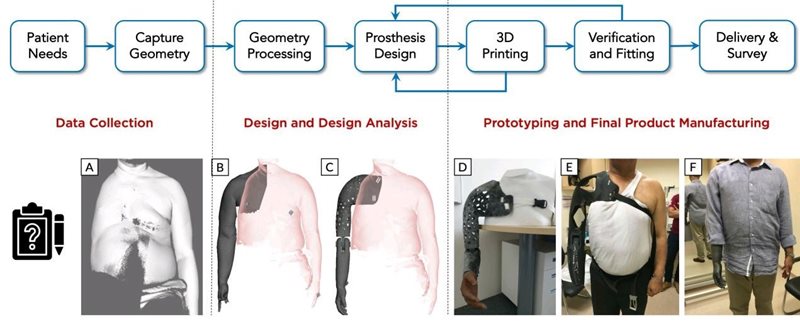Low cost, customised prosthesis using 3D printing
SUTD - Eugene Meng and Karupppasamy Subburaj
Tan Tock Seng Hospital / SUTD - Trevor Binedell
SUTD, together with Tan Tock Seng Hospital, developed a novel 3D printed non-metallic self-locking prosthetic arm for a patient with a forequarter amputation – it is more comfortable, flexible and 20% cheaper than a conventional prosthesis.
 The schematic representation of the various stages involved in the user-centered, iterative process of prosthesis design.
The schematic representation of the various stages involved in the user-centered, iterative process of prosthesis design.
Upper limb forequarter amputations which involve the removal of the entire arm and scapula require highly customised prosthetic devices that are expensive but yet, usually underutilised due to their high maintenance and low comfort levels. At the same time, while cosmetic prostheses - artificial limbs which provide patients the appearance of a pre-amputated body part - have a higher rate of continuous use, they have limitations in functional use.
Combining both technical and clinical expertise, the Singapore University of Technology and Design’s (SUTD) Medical Engineering and Design Laboratory collaborated with Tan Tock Seng Hospital’s (TTSH) Foot Care and Limb Design Centre, the largest provider of prosthetic services in Singapore, on a patient-specific upper limb prosthesis. This cosmetic prosthesis with a self-locking function was found to be more comfortable and around 20 percent cheaper compared to similar prostheses available in the industry.
To reduce the underutilisation and delivery time, while taking improved fit, function and comfort into consideration, the research team turned to 3D printing due to its versatility and ability to cater to the device’s geometrical and functional complexity.
The team also adopted a user-centered design approach, involving the patient throughout the customised design and development process. They then meticulously captured and documented the design process so that it can serve as a blueprint for other device applications or be replicated for other patients with limb amputations, thus reducing the over reliance on a prosthetist’s judgement, skills and experience for an optimal fit.
Based on regular consultations with the patient and prosthetist at TTSH, including the shadowing of the patient to better understand his daily activities and functional needs, it was concluded that the new prosthesis needed to be lightweight, capable of dissipating heat, locking at 90° of flexion, comfortable to wear and void of metal components that would be detectable by airport scanners.
The research team used a digital scanner to capture residuum and contralateral arm geometries to replicate the patient’s arm with high precision. They then designed different parts of the prosthesis from the captured geometries, 3D printed and verified these for fit, comfort, and function (refer to image). Their research paper was published in the Prosthetics and Orthotics International Journal.
The patient’s satisfaction for the 3D printed prosthesis over his conventionally made prosthesis rated higher for its overall effectiveness, accurate size, symmetrical appearance and ease of use. Even though the new prosthesis weighed 100 grams more than the current prosthesis, the patient preferred it due to its improved suspension contributing to the feel of a lighter arm during use. However, the prosthesis was perceived to be less durable due to the patient’s unfamiliarity with the quality of 3D printing, his concerns of the elbow locking mechanism breaking, and the appearance of the mesh structure compared to his current prosthesis.
“Digitalisation and 3D printing have been transforming the design and manufacture of complex medical devices, surgery planning, medical education, and care delivery. Even though 3D printing technology has been around for more than three decades since the early 90’s, it wasn’t until recently that people really began to appreciate and trust it for end-use fabrication. In this work, 3D printing freed us from the manufacturing constraints and enabled us to optimise the design to suit the patient’s needs. More importantly, this work sets the groundwork for future patient-specific end-use 3D printed parts for prosthetic needs,” said principal investigator, Assistant Professor Subburaj Karupppasamy from SUTD’s Engineering Product Development pillar.
Trevor Binedell, Principal Prosthetist at the Foot Care and Limb Design Centre, TTSH, and PhD student from SUTD, added, “The collaboration between TTSH and SUTD has led to a great outcome for this patient. User-design and the digitalisation techniques have elevated the levels of patient-specific care to create individual designs that truly meet the needs of the user. This process has the potential to improve unique designs for many of our patients and enhance their quality of lives.”
Reference:
Design and development of a novel 3D-printed non-metallic self-locking prosthetic arm for a forequarter amputation, Prosthetics and Orthotics International Journal. (DOI: 10.1177/0309364620948290)
Acknowledgments:
The author(s) disclosed receipt of the following financial support for the research, authorship and/or publication of this article: This project was funded by the National Additive Manufacturing – Innovation Cluster (NAMIC 2017269) with in-kind support from Tan Tock Seng Hospital and Singapore University of Technology and Design.